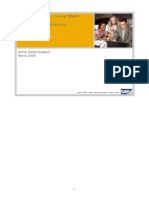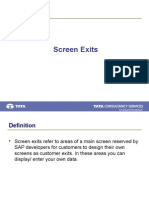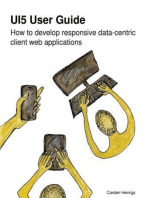What Are The Basic Components of SAP R/3 Business Framework ?
What Are The Basic Components of SAP R/3 Business Framework ?
Uploaded by
ram krishnaCopyright:
Available Formats
What Are The Basic Components of SAP R/3 Business Framework ?
What Are The Basic Components of SAP R/3 Business Framework ?
Uploaded by
ram krishnaOriginal Description:
Original Title
Copyright
Available Formats
Share this document
Did you find this document useful?
Is this content inappropriate?
Copyright:
Available Formats
What Are The Basic Components of SAP R/3 Business Framework ?
What Are The Basic Components of SAP R/3 Business Framework ?
Uploaded by
ram krishnaCopyright:
Available Formats
What are the basic components of SAP R/3 Business Framework ?
Business Components
SAP Business Components provide autonomous business functions
and consist of business objects. For example, the business objects Employee and Applicant are assigned to
the Business Component Human Resources. Business processes are either implemented within a Business
Component or across several Components (distributed business processes).
Business Objects
The object-oriented structure of the R/3 System is based on Business Objects. They encapsulate business
data and functionality and define the functional scope and boundaries of a Business Component.
Business Application Programming Interfaces (BAPI)
BAPIs are interfaces for Business Objects. Together with the Business Objects, BAPIs define and document
the interface standard at the business level.
Integration Service, Application Link Enabling (ALE)
The ALE Integration Service enables the integration of business processes that are carried out in different
R/3 and non-SAP systems. This service is based on the system-wide distribution of Business Objects using
the ALE distribution model.
Communication Services
These are the communication technologies, for example, Distributed Component Object Model (DCOM)
and Remote Function Call (RFC) that use the Business Framework to access BAPIs.
2. What is SAP Business Objects ?
A business object type, which represents of a business entity in the SAP R/3 System, encompasses both the
functionality (in the form of methods) and the data (in the form of attributes) of this entity. The
implementation details of the business object type are hidden from the user. The business object type is
accessed through defined functions (methods). This is referred to as encapsulation.
Business object types form the point of entry to the data and the functionality of the SAP R/3 System. At the
business object type level, both non-SAP systems and the various SAP business components can
communicate with each other.
The business object type Sales Order represents a customer’s request to the company to supply a particular
quantity of material at a certain point in time or to perform services at a certain point in time. A specific sales
order is identified by a sales document number. The business object type contains all the necessary information
for a sales order: sold-to party, sales organization, document date, net value of the order, and currency of the
sales and distribution document.
3. What is BAPI ?
BAPIs are defined as API methods of SAP Business Object Types. These object types are used within the
Business Framework to enable object-based communication between components. Business objects and their
BAPIs enable object orientation to be used in central information processing in companies.
4. What need to be taken care while handling database transaction in BAPI ?
A transaction is completed either using a COMMIT WORK command or a ROLLBACK command.
A BAPI transaction must be ended by calling the BAPIs BapiService.TransactionCommit() or
BapiService.TransactionRollback().
The call of a BAPI must not trigger further LUWs that are independent of the BAPI. For this reason
BAPIs must not contain the following commands:
CALL TRANSACTION
SUBMIT REPORT
SUBMIT REPORT AND RETURN
5. What is BOR (Business Object Repository) ?
The Business Object Repository (BOR) is the central access point for the SAP business object
types and their BAPIs. The BOR contains all the relevant information on the SAP business object
types, their key fields, and their BAPI methods that are needed to integrate the correct object type
definitions and BAPI calls in an application program. This makes the integration of middleware
(such as the DCOM Connector, ActiveX Controls, CORBA Gateway, and so on) possible.
Creates instances of SAP business objects. The runtime environment of the BOR receives
requests to create runtime objects from client applications and creates the appropriate object
instances.
6. What is the difference between RFC and BAPI?
BAPI :
BAPI is a library of function modules released by SAP to the public so that they can interface with SAP.
There is a Business Object Associated with a BAPI. So a BAPI has an Interface, Key Field, Attributes, Methods,
and Events.
Outside world (JAVA, VB, .Net or any Non SAP system) can connect to SAP using a BAPI.
Error or Success messages are returned in a RETURN table.
RFC
RFC is nothing but a remote enabled function module. So if there is a Function Module in SAP system 1 on
server X , it can be called from a SAP system 2 residing on server Y.
No Business Object is associated with a RFC.
Non–SAP world cannot connect to SAP using RFC.
RFC does not have a return table.
7. What is the difference between BDC and BAPI?
BAPI
BAPI is faster than BDC.
BAPI directly updates database.
BAPI would generally used for small data uploads.
For processing errors, the Return Parameters for BAPI should be used.This parameter returns exception
messages or success messages to the calling program.
BDC
BDC goes through all the screens as a normal user would do and hence it is slower.
Background and Foreground processing options are available for BDC.
BDCs would be preferred for large volumes of data upload since background processing option is available.
Errors can be processed in SM35 for session method and in the batch input program for Call Transaction
method.
8. What are the steps for creating a BAPI ?
Stage1: Creating a structure in SE11
Stage2: Creating the function module in SE37
Stage 3: Creating the business object in SWO1
Stage 4: Viewing the created BAPI in BAPI Explorer
You might also like
- Integrative Programming and Technologies Chapter-1Document14 pagesIntegrative Programming and Technologies Chapter-1nigussie76% (21)
- Enhancement Framework Badi DevelopmentDocument27 pagesEnhancement Framework Badi DevelopmentAshwani KumarNo ratings yet
- Difference Between RFC and BAPIDocument2 pagesDifference Between RFC and BAPIPILLINAGARAJUNo ratings yet
- Inside VOFMDocument36 pagesInside VOFMthuanderNo ratings yet
- Debugger FundamentalsDocument49 pagesDebugger Fundamentalscbrigati100% (1)
- ABAP Runtime Analysis (SE30) - How To Analyze A..Document15 pagesABAP Runtime Analysis (SE30) - How To Analyze A..raky0369No ratings yet
- Generate Bapi ALE InterfaceDocument36 pagesGenerate Bapi ALE Interfaceprakashvdasari4647No ratings yet
- Z Reports - SCNDocument3 pagesZ Reports - SCNAnkit GargNo ratings yet
- File To RFC Without BPMDocument7 pagesFile To RFC Without BPMapi-3722276100% (2)
- Exposing The XI Monitoring Functionality As A Web ServiceDocument20 pagesExposing The XI Monitoring Functionality As A Web Servicedash.skNo ratings yet
- Configure SCOTDocument17 pagesConfigure SCOTamitkumarghosh78100% (1)
- Substitution in WorkflowDocument14 pagesSubstitution in WorkflowSrinivasan SriNo ratings yet
- Workflow PDFDocument8 pagesWorkflow PDFajit sahuNo ratings yet
- Configuration of Enterprise Services Using SICF and SOA ManagerDocument25 pagesConfiguration of Enterprise Services Using SICF and SOA ManagergmartinsNo ratings yet
- ABAP Mapping Steps 1Document12 pagesABAP Mapping Steps 1RAMESH100% (1)
- Bapi Step by Step ExampleDocument31 pagesBapi Step by Step ExampleSunil Dutt SharmaNo ratings yet
- All About Transport RequestDocument6 pagesAll About Transport Requestksan8291100% (1)
- Classic BADI With Single UseDocument25 pagesClassic BADI With Single UseanilNo ratings yet
- BADI and It's Implementation in SAPDocument13 pagesBADI and It's Implementation in SAPKaushik BoseNo ratings yet
- Screen ExitsDocument36 pagesScreen Exitsapi-3738703100% (4)
- Stock Transfer Order Process in SAPDocument45 pagesStock Transfer Order Process in SAPhafsarajabunissaNo ratings yet
- Creating VOFM Custom RoutineDocument12 pagesCreating VOFM Custom RoutineAshok kumar kethineni100% (1)
- Find User Exit in SAP TransactionDocument5 pagesFind User Exit in SAP TransactionShaffiullahNo ratings yet
- Fiori Front Server 4.0 Implementation GuideDocument20 pagesFiori Front Server 4.0 Implementation GuideZABIBHAINo ratings yet
- IDoc To RNIF ScenarioDocument12 pagesIDoc To RNIF ScenarioBenedikt Reliewgreb0% (1)
- Fiori Analytical App Configuration Steps For Beginners SAP BlogsDocument10 pagesFiori Analytical App Configuration Steps For Beginners SAP BlogsVilas PatilNo ratings yet
- SAP Service Configurations - SAP MMDocument11 pagesSAP Service Configurations - SAP MMbeema1977No ratings yet
- SAP Threeway Match Functionality & Configuration - SAP BlogsDocument6 pagesSAP Threeway Match Functionality & Configuration - SAP Blogsshiv0308100% (1)
- 1295 HCL Abap CodingDocument85 pages1295 HCL Abap Codingvinayistha100% (1)
- BAPI For PODocument3 pagesBAPI For POatulk103100% (2)
- Debugging With External BreakpointsDocument7 pagesDebugging With External BreakpointsSatyajit MishraNo ratings yet
- Web Services With Application Server Abap: AbstractDocument6 pagesWeb Services With Application Server Abap: Abstractsl4ckwar3No ratings yet
- F-13 Vendor Automatic Account ClearingDocument6 pagesF-13 Vendor Automatic Account ClearingDipak kumar PradhanNo ratings yet
- ABAP Performance and TuningDocument6 pagesABAP Performance and Tuningdharm2501No ratings yet
- EDI To IDOC Development Using B2B AddDocument3 pagesEDI To IDOC Development Using B2B AddMurali MuddadaNo ratings yet
- ABAP Best Practices - Code InspectorDocument3 pagesABAP Best Practices - Code InspectorinturimadhavaraoNo ratings yet
- SFTP Adapter Documentation For SAP PI 7Document6 pagesSFTP Adapter Documentation For SAP PI 7Sameer WarsiNo ratings yet
- How To Apply A Note in SAP SystemDocument7 pagesHow To Apply A Note in SAP SystemGunjan JaiswalNo ratings yet
- Developer Extensibility For SAP S4HANA Cloud On The SAP API Business HubDocument8 pagesDeveloper Extensibility For SAP S4HANA Cloud On The SAP API Business Hubkoizak3No ratings yet
- Question ALVDocument14 pagesQuestion ALVHieu NguyenNo ratings yet
- PI NotesDocument105 pagesPI NotesshravanNo ratings yet
- SAP HANA Vs SAP S - 4 HANA - Is There Any Difference Between The Two - DataFlairDocument2 pagesSAP HANA Vs SAP S - 4 HANA - Is There Any Difference Between The Two - DataFlairShubham SharmaNo ratings yet
- Sap Abap Ale Idoc OverviewDocument32 pagesSap Abap Ale Idoc OverviewBunty JainNo ratings yet
- SCOT ConfigurationDocument8 pagesSCOT ConfigurationRaghavendhar ReddyNo ratings yet
- Sap Java AdminDocument8 pagesSap Java AdminSAP R/3No ratings yet
- How To Create Transport of Copies (Toc) in SapDocument7 pagesHow To Create Transport of Copies (Toc) in SapjaberyemeniNo ratings yet
- Custom Fiori Applications in SAP HANA: Design, Develop, and Deploy Fiori Applications for the EnterpriseFrom EverandCustom Fiori Applications in SAP HANA: Design, Develop, and Deploy Fiori Applications for the EnterpriseNo ratings yet
- Architecting Solutions with SAP Business Technology Platform: An architectural guide to integrating, extending, and innovating enterprise solutions using SAP BTPFrom EverandArchitecting Solutions with SAP Business Technology Platform: An architectural guide to integrating, extending, and innovating enterprise solutions using SAP BTPNo ratings yet
- Mastering SAP ABAP: A complete guide to developing fast, durable, and maintainable ABAP programs in SAPFrom EverandMastering SAP ABAP: A complete guide to developing fast, durable, and maintainable ABAP programs in SAPNo ratings yet
- UI5 User Guide: How to develop responsive data-centric client web applicationsFrom EverandUI5 User Guide: How to develop responsive data-centric client web applicationsNo ratings yet
- Business Application Programming Interface BAPI Standard RequirementsFrom EverandBusiness Application Programming Interface BAPI Standard RequirementsNo ratings yet
- BAPI in SAP ABAPDocument15 pagesBAPI in SAP ABAPjunaidNo ratings yet
- Bapi & RFCDocument45 pagesBapi & RFCअंशुल मिश्राNo ratings yet
- BDC: Batch Data CommunicationsDocument6 pagesBDC: Batch Data CommunicationsSatya BobbaNo ratings yet
- Intelligent AttendanceDocument14 pagesIntelligent Attendanceram krishnaNo ratings yet
- A Machine Learning Model For Average Fuel Consumption in Heavy VehiclesDocument23 pagesA Machine Learning Model For Average Fuel Consumption in Heavy Vehiclesram krishna100% (5)
- Triggering AlertsDocument13 pagesTriggering Alertsram krishnaNo ratings yet
- A Machine Learning Model For Average Fuel Consumption in Heavy VehiclesDocument20 pagesA Machine Learning Model For Average Fuel Consumption in Heavy Vehiclesram krishnaNo ratings yet
- Video-Based Abnormal Driving Behavior Detection Via Deep Learning FusionsDocument18 pagesVideo-Based Abnormal Driving Behavior Detection Via Deep Learning Fusionsram krishna100% (2)
- General BAPI Interview QuestionsDocument7 pagesGeneral BAPI Interview Questionsram krishnaNo ratings yet
- Finance ProjectDocument79 pagesFinance Projectram krishna100% (1)
- Object Oriented Analysis and Design - Part2Document40 pagesObject Oriented Analysis and Design - Part2Kỉ Nguyên Hủy DiệtNo ratings yet
- Lab ManualDocument24 pagesLab ManualMohan Raj K100% (1)
- Software Design Document (SDD) Template: IEEE STD 1016 1998Document7 pagesSoftware Design Document (SDD) Template: IEEE STD 1016 1998Dina KharistaNo ratings yet
- STM Unit 11Document70 pagesSTM Unit 11AshokAbiNo ratings yet
- OAF - Oracle Application Framework MaterialDocument72 pagesOAF - Oracle Application Framework MaterialRabindra P.SinghNo ratings yet
- هندسة برامجياتDocument78 pagesهندسة برامجياتrayan alkurdiNo ratings yet
- 1.4the Software ProcessDocument6 pages1.4the Software ProcessMohan xeroxNo ratings yet
- CS 349 Software Engineering Syllabus VER 1.0Document4 pagesCS 349 Software Engineering Syllabus VER 1.0YASH GAIKWADNo ratings yet
- G UDREzhal VIDocument304 pagesG UDREzhal VIOche FauzanNo ratings yet
- Systems Development Design, Implementation, Maintenance, and RevieDocument14 pagesSystems Development Design, Implementation, Maintenance, and RevieAditya Singh100% (3)
- Software Quality ArrtibutesDocument18 pagesSoftware Quality ArrtibutesJackson ChuaNo ratings yet
- Airline Reservation System Project Report in ASP NetDocument55 pagesAirline Reservation System Project Report in ASP NetFHIT ChikkabanavaraNo ratings yet
- OAF TrainiingDocument23 pagesOAF TrainiingCoral Shiny0% (1)
- Federation of Cloud Computing InfrastructureDocument5 pagesFederation of Cloud Computing InfrastructureIJSTENo ratings yet
- Negotiation Support and E-Negotiation Systems An ODocument35 pagesNegotiation Support and E-Negotiation Systems An Onoxy58No ratings yet
- Engineering Edge Issue6 Vol1Document72 pagesEngineering Edge Issue6 Vol1JocaNo ratings yet
- Application FrameworkDocument2 pagesApplication FrameworkRio Puja Laksana100% (1)
- INF305 Notes (Pressman)Document57 pagesINF305 Notes (Pressman)dinesh_panchariaNo ratings yet
- MC Case StudyDocument5 pagesMC Case StudyykommaNo ratings yet
- Ponents of DSSDocument7 pagesPonents of DSSDeep BhalodiaNo ratings yet
- SCADAVision OverviewDocument4 pagesSCADAVision Overviewrealdeal01No ratings yet
- WSCC Long All 5 Units PossibleDocument30 pagesWSCC Long All 5 Units PossibleNithin kumarNo ratings yet
- Software Engineering MCQ (Multiple Choice Questions)Document26 pagesSoftware Engineering MCQ (Multiple Choice Questions)Nazir AbdulkareemNo ratings yet
- Script Papan Catur 3DDocument27 pagesScript Papan Catur 3DAkbar SalehNo ratings yet
- Error and Fault TaxonomyDocument47 pagesError and Fault TaxonomyAryaman SinghNo ratings yet
- Simaticpcs7 Stpcs7 Complete English 2010 02Document404 pagesSimaticpcs7 Stpcs7 Complete English 2010 02Eliud RodriguezNo ratings yet
- Project Oxygen DocumentationDocument34 pagesProject Oxygen DocumentationSri Bharath BhagavathiNo ratings yet
- Quality Assurance ProcessDocument130 pagesQuality Assurance Processbrijeshcoco100% (1)
- CMMI V1.2 M03 EngineeringDocument153 pagesCMMI V1.2 M03 EngineeringcskijanjeNo ratings yet
































































































